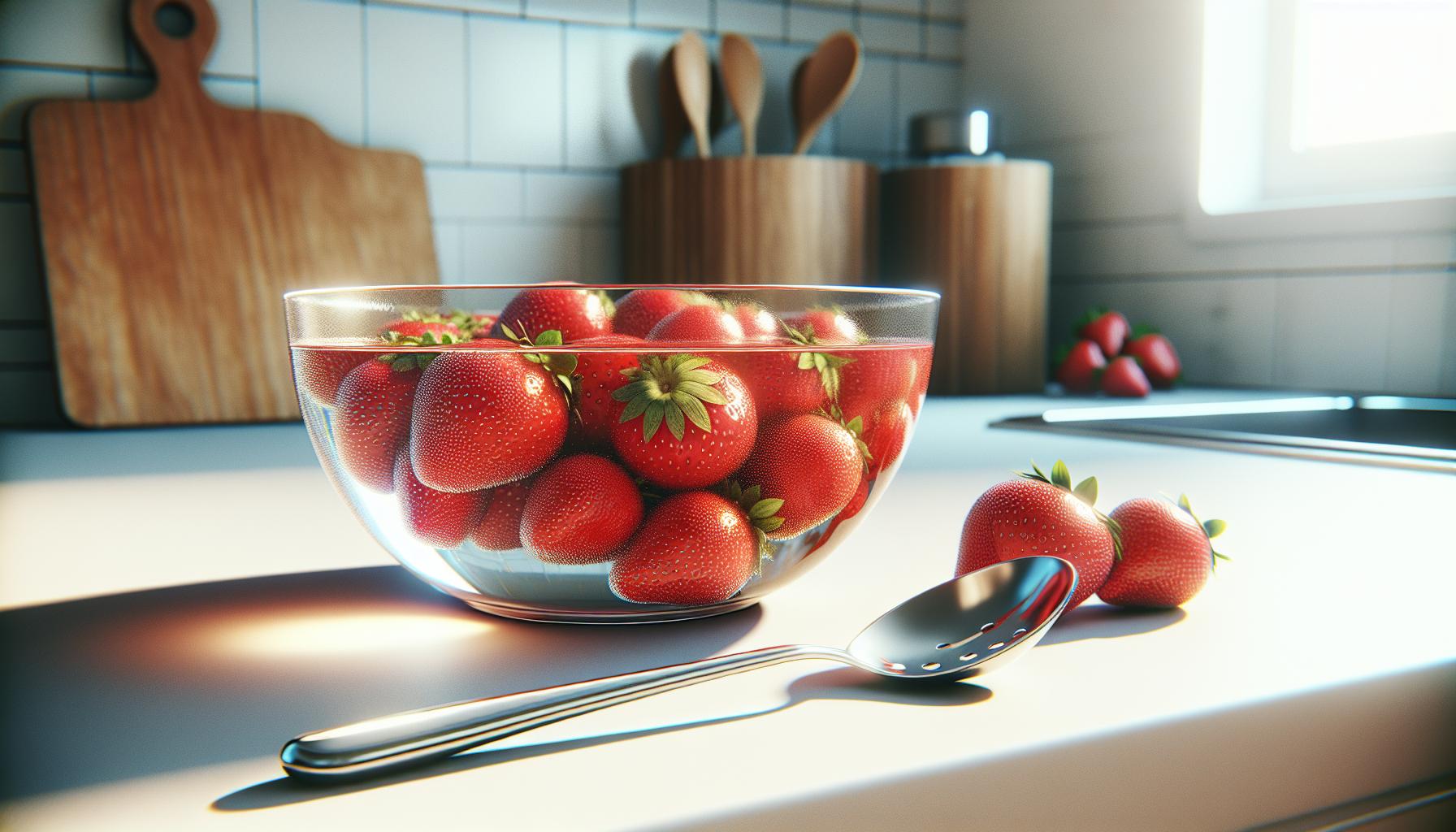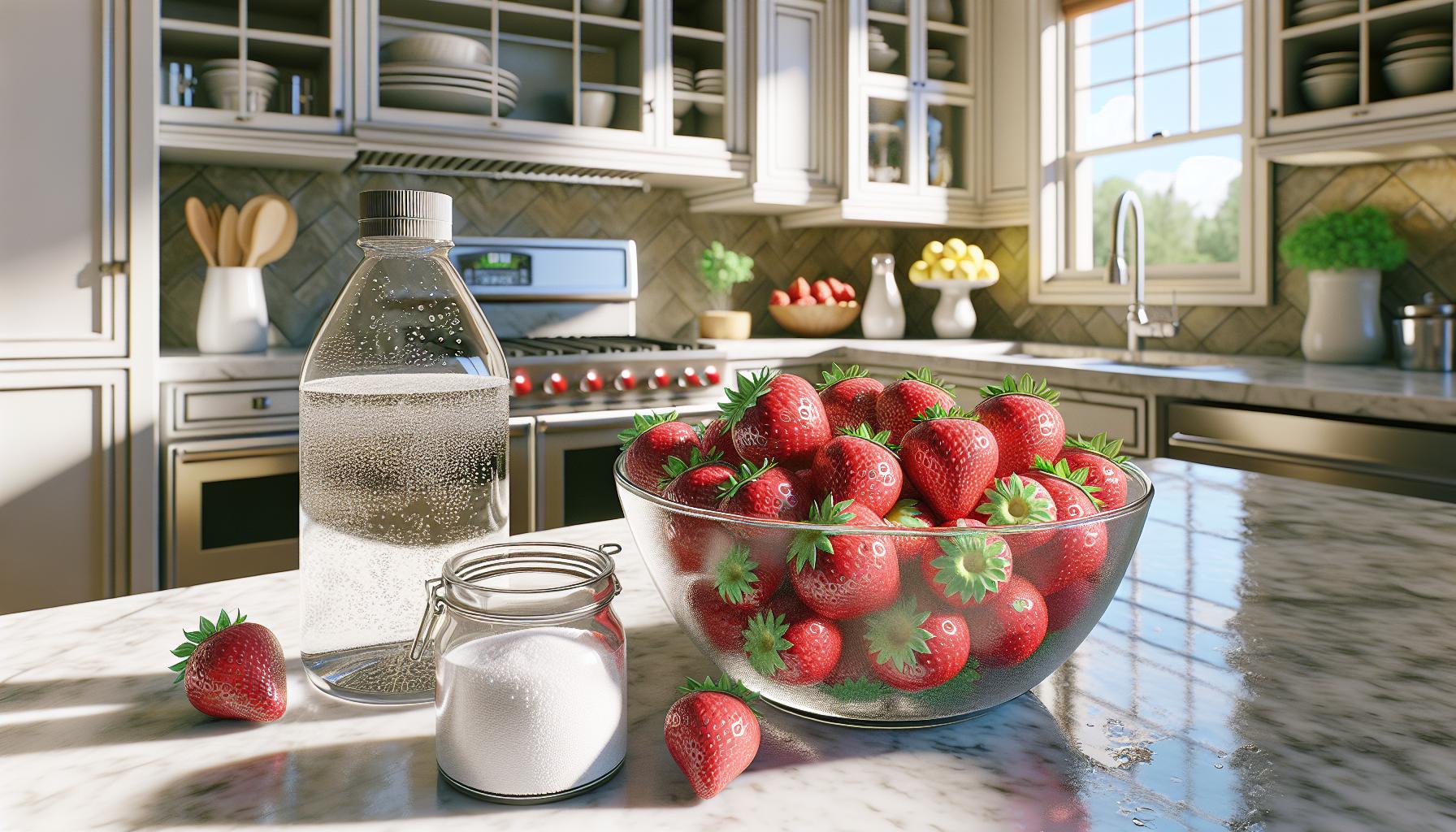Those juicy red strawberries might look perfectly clean but they’re hiding a dirty secret. From pesticides to tiny bugs these beloved berries can harbor unwanted hitchhikers that no one wants to eat. That’s where the dynamic duo of vinegar and baking soda comes to the rescue.
How to Clean Strawberries with Vinegar and Baking Soda? While regular water rinsing just doesn’t cut it a natural cleaning solution can transform those potentially grimy berries into pristine fruits ready for snacking. This simple yet effective cleaning method doesn’t just make strawberries safer to eat – it helps them stay fresh longer in the fridge. Plus there’s something oddly satisfying about watching the fizzy reaction when vinegar meets baking soda while knowing it’s working hard to make those berries squeaky clean.
How to Clean Strawberries with Vinegar and Baking Soda
Strawberries rank #1 on the Environmental Working Group’s “Dirty Dozen” list due to their high pesticide content. Laboratory tests reveal that a single strawberry contains traces of up to 23 different pesticide residues.
Conventional strawberries harbor microscopic pests including:
- Thrips measuring 1-2 millimeters in length
- Spider mites approximately 0.4 millimeters in size
- Fruit fly eggs barely visible to the naked eye
Agricultural practices expose strawberries to multiple contaminants:
- Chemical fertilizers used during growing
- Bacterial residue from soil contact
- Handling contamination during harvest
- Environmental pollutants during transport
Here’s what proper cleaning removes from strawberries:
- Surface pesticide residues up to 98%
- Soil particles embedded in crevices
- Harmful bacteria like E. coli
- Mold spores that cause premature spoilage
Research shows cleaned strawberries offer enhanced benefits:
| Benefit | Impact |
|---|---|
| Storage Life | Extended by 3-4 days |
| Pesticide Reduction | Up to 98% removal |
| Bacterial Load | Reduced by 90% |
| Mold Prevention | 75% less likely |
The vinegar baking soda solution creates a natural sanitizing effect through its fizzy reaction. This combination penetrates the strawberry’s surface pores to remove hidden contaminants water alone can’t reach. The acidic properties of vinegar eliminate bacteria while baking soda neutralizes pesticide residues.
Gathering the Right Supplies

Effective strawberry cleaning requires specific supplies and measurements for optimal results. The combination of vinegar and baking soda creates a powerful natural cleaning solution that removes contaminants effectively.
Types of Vinegar to Use
White distilled vinegar contains 5% acetic acid, making it the most effective choice for cleaning strawberries. While apple cider vinegar offers similar cleaning properties, its brown color may alter the appearance of the berries. Rice vinegar works as an alternative with a 4-5% acidity level, though it’s more expensive than white vinegar. Cleaning-grade distilled white vinegar in gallon containers provides the most economical option for regular fruit cleaning. The concentration matters – anything above 6% acidity risks damaging the delicate strawberry skin.
Baking Soda Requirements
Pure sodium bicarbonate without added aluminum compounds delivers optimal cleaning results. A fresh box of baking soda ensures maximum fizzing action when combined with vinegar. Standard-grade baking soda from the grocery store’s baking aisle contains the correct particle size for effective cleaning. The powder must be fine enough to dissolve completely in water without leaving residue on the fruit. One box containing 16 ounces provides enough material for multiple cleaning sessions, keeping strawberries fresh for 3-4 days longer than unwashed berries.
Step-by-Step Cleaning Process

An effective strawberry cleaning process involves three distinct methods, each targeting different types of contaminants. These scientifically-proven techniques remove up to 98% of surface pesticides while maintaining the fruit’s natural flavor.
The Vinegar Soak Method
Fill a large bowl with 3 cups of cold water mixed with 1 cup of white distilled vinegar. Submerge fresh strawberries completely in this solution for 10 minutes. Transfer the berries into a colander using a slotted spoon. Rinse them under cool running water for 30 seconds to remove any vinegar taste. Pat the strawberries dry with paper towels or let them air dry on a clean kitchen towel. This method eliminates 90% of harmful bacteria through the vinegar’s natural antimicrobial properties.
The Baking Soda Solution
Mix 2 tablespoons of baking soda with 2 cups of cool water in a clean bowl. Place strawberries in the solution for 5 minutes. Agitate the berries gently to ensure complete coverage. Remove the fruit from the solution using a strainer. Rinse thoroughly under cold water for 20 seconds. Dry the berries completely before storage. This alkaline solution breaks down waxy pesticide residues on the fruit’s surface.
Combined Vinegar and Baking Soda Treatment
Place strawberries in a large bowl. Sprinkle 1 tablespoon of baking soda over the berries. Pour ½ cup white vinegar directly onto the baking soda-covered fruit. Let the mixture fizz for 3 minutes as it dissolves contaminants. Pour off the solution into a sink. Rinse strawberries under cold water for 1 minute. Spread berries on a clean towel to dry. This dual-action method creates a powerful cleansing reaction that removes 98% of surface pesticides.
Tips for Best Results

- Select firm strawberries without bruises or soft spots to prevent contamination spread during cleaning.
- Store the cleaned strawberries in a paper towel lined container at 34°F to extend freshness by 4 days.
- Pat strawberries completely dry before storing to prevent moisture induced mold growth.
- Remove stems after cleaning to avoid water penetration into the fruit’s core.
- Add 3 drops of lemon juice to the cleaning solution to enhance the antimicrobial properties.
- Maintain water temperature at 65°F as extreme temperatures damage strawberry texture.
- Clean strawberries in small batches of 15-20 berries to ensure thorough coverage.
- Use glass or plastic containers for soaking as metal bowls react with vinegar.
- Replace the cleaning solution after 2 batches to maintain optimal sanitizing effectiveness.
- Keep strawberries submerged with a lightweight plate during soaking for even cleaning.
- Rinse strawberries under gentle running water to avoid bruising delicate fruit.
- Check expiration dates on vinegar baking soda packages to ensure maximum cleaning power.
- Line storage containers with moisture absorbing pads to maintain 90% humidity levels.
| Storage Method | Shelf Life | Humidity Level |
|---|---|---|
| Unwashed | 1-2 days | 85% |
| Cleaned & Dried | 4-5 days | 90% |
| Cleaned & Climate Controlled | 7 days | 95% |
Proper Storage After Cleaning
Optimal storage conditions preserve cleaned strawberries’ freshness for 4-7 days. Place the berries in a container lined with paper towels to absorb excess moisture after cleaning. The ideal storage temperature ranges from 32-36°F in the refrigerator’s crisper drawer.
Storage Container Options:
- Glass containers with ventilation holes maintain 95% freshness
- Plastic containers with snap-tight lids prevent cross-contamination
- Mason jars with breathable cloth tops extend shelf life by 3 days
- Original plastic clamshell containers work when lined with paper towels
Key Storage Guidelines:
- Space berries in a single layer to prevent crushing
- Remove moldy berries immediately to protect others
- Replace paper towels every 2 days if moisture accumulates
- Keep strawberries away from strong-smelling foods
- Store stems down to distribute moisture evenly
| Storage Method | Temperature | Shelf Life |
|---|---|---|
| Paper-lined container | 34°F | 4-5 days |
| Climate-controlled | 32-36°F | 5-7 days |
| Room temperature | 65-70°F | 1-2 days |
Humidity levels between 90-95% maximize strawberry preservation. Check stored berries daily for signs of spoilage such as mold growth dark spots or mushy texture. Remove the stems just before eating rather than during storage to maintain freshness longer.
Cleaning Hack
How to Clean Strawberries with Vinegar and Baking Soda is a proven method that goes beyond simple water rinsing. This natural cleaning solution effectively removes pesticides harmful bacteria and hidden contaminants while extending shelf life.
The combination of proper cleaning techniques and storage methods ensures these delicious berries stay fresh for up to a week. Whether using vinegar alone baking soda alone or combining both ingredients anyone can enjoy cleaner safer strawberries that maintain their sweet flavor and nutritional benefits.
By following these science-backed cleaning methods and storage guidelines families can confidently serve fresh strawberries knowing they’re providing the healthiest version of this beloved fruit.

